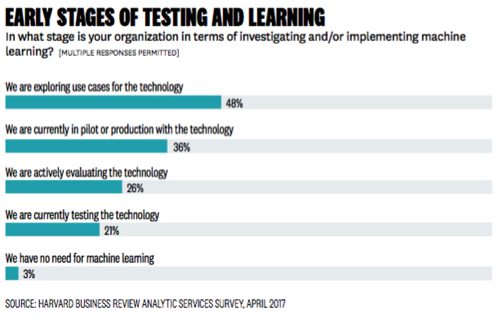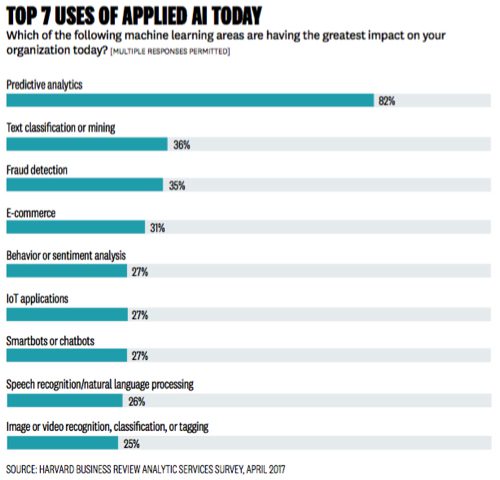Artificial intelligence and business, it seems, is a marriage that is all but inevitable. Artificial intelligence is intelligence built into computing systems, or as MIT professor Marvin Minsky put it, “the science of making machines do those things that would be considered intelligent if they were done by people.” In sum, this concept of extending the “intelligence” of systems is the core of how AI enables critical advantage for businesses.
AI isn’t new. People use it every day in their personal and professional lives. What is new is are new business offerings thanks to two major factors: 1) a massive increase in computer processing speeds at reasonable costs, and 2) massive amounts of rich data for mining and analysis.
AI accomplishes business activities with greater accuracy and at a fraction of the time that humans take. But it’s no slam dunk: AI can be expensive to buy and install, takes a lot of management cost and time, and has some ethical baggage. Its benefits often outweigh its disadvantages, so we’ll look at both.

This report from Harvard Business Review reflects the nascent use of AI in business, with the many respondents in the exploration phase.
InfoSys in its survey report Amplifying Human Potential: Towards Purposeful Artificial Intelligence reported that the most popular AI technologies for business were big data automation, predictive analysis, and machine learning. Additional important drivers include business intelligence systems and neural networks for deep learning.
Certain industries have adopted advanced deployments of AI at a faster rate than others. Pharma/life sciences, automotive and aerospace, telecoms, energy, oil/gas and utilities, manufacturing, shipping logistics, healthcare, and financial services lead the pack.
Artificial intelligence in business brings AI benefits – and challenges – into business areas including marketing, customer service, business intelligence, process improvement, management, and more.
Major Use Cases for Artificial Intelligence in Business
The biggest use cases driving AI in business include automating job functions, improving business processes and operations, performance and behavior predictions, increasing revenue, pattern recognition, and business insight.
1. Automate job functions to improve efficiency. This driver crosses industry verticals and horizontals, and includes any repetitive job function that AI can automate. Manufacturing robots are the most obvious example but far from the only one. AI can automate any job function that requires repeated manual input, such as generalist IT functions. AI also drives efficiency by automating machine workloads, such as collecting and analyzing sensor data. And for better or worse, the public is used to automated phone attendants, chats, and emails that are driven by AI.
2. Improve business processes. Process improvement is well advanced in manufacturing, where industrial robots have made inroads for many years. AI also improves business processes in transportation and logistical supply chains, such as dynamically adjusting trucking routes by tracking weather and traffic delays. Business continuity uses AI systems that automatically detect and mitigate anomalies like power surges or potential security breaches. Another important AI frontier is biomedicine. Matching donor kidneys to transplant patients is traditionally a long and laborious process because the patient and donor population frequently changes. A Carnegie Mellon University research team created AI technology to accelerate and improve the matching process.
3. Predict performance and behavior. AI applications can predict time to performance milestones based on progress data, and can enable customized product offers to web search and social media users. Predictive AI is not limited to traditional business: Disney Labs, Caltech, STATS, and Queensland University partnered to develop a deep learning system called Chalkboard. The neural network analyzes players’ decision-making processes based on their past actions, and suggests optimal decisions in future plays.
4. Increase revenue. Companies can increase revenue by using AI in sales and marketing. For example, Getty Images uses predictive marketing software Mintigo. The software crawls millions of websites and identifies sites that are using images from competitive services. Mintigo manages the huge sales intelligence database, and generates actionable recommendations to Getty sales teams. Northface uses IBM Watson to analyze voice input AI technology and recommend products. If a customer is looking for a jacket, the retailer asks customers what, when, and where they need the jacket. The customer speaks their response, and Watson scans a product database to locate two things: 1) a jacket that best fits the customer’s stated needs, and 2) cross-references the recommendation by weather patterns and forecasts in the customer’s stated area.
5. Pattern recognition. AI pattern recognition improves investigations into non-compliance or fraud in digital communications, while social semantics and sentiment analysis works for purposes as different as social media marketing and terrorist investigations. Customer activity patterns can also generate product recommendations and content curation. Netflix saves $1 billion a year by using AI to recommend videos customized to each viewer. Netflix discovered that viewers are 4-5 more times more likely to click on a video that appears on their Netflix recommendations screen. Netflix uses their AI system to track individual watching patterns, then recommends less well-known videos to the viewer. This system optimizes Netflix’ $6 billion a year content spend, since most of these videos are less expensive for Netflix to buy than blockbuster premium content.
6. Business insight. AI can interpret big data for better insight across the board: assets, employees, customers, branding, and more. Increasingly AI applications work with unstructured data as well as structured, and can enable businesses to make better and faster business decisions. For example, sales and marketing AI applications suggest optimal communication channels for content marketing and networking to best prospects.

Based on the HBR report, predictive analytics is a leading business use of AI, followed closely by text classification and fraud detection.
For all its benefits, AI projects are often costly and complex and come laden with security and privacy concerns. Don’t let these issues blindside you: carefully research the business challenges around AI, and compare the costs of adopting an AI system against losing its benefits.
· AI is expensive. Advanced AI does not come cheap. Purchase and installation/integration prices can be high, and ongoing management, licensing, support, and maintenance will drive costs higher. Build your business case carefully; not just to sell senior management, but to understand if the high cost is worth the benefits – especially if a big business driver is cost reduction.
· AI takes time. Give installation plenty of time in your project plan, and build your infrastructure before the system arrives. High-performance AI needs equally high-performance infrastructure and massive storage resources. Businesses also need to train or hire people with the knowledge skills to manage AI applications, and complex AI systems will require training time and resources. Many businesses will decide to outsource some or all their AI management; often a good business decision but an added cost.
· AI needs to be integrated. There may also be integration challenges. If your AI project will impact existing systems like ERP, manufacturing processes, or logistics systems, make sure your engineers know how to identify and mitigate interoperability or usability issues. Businesses also need to adopt big data analytics infrastructure for predictive and business intelligence AI applications.
· AI has security and privacy concerns. Cybersecurity is as important for AI applications as it is for any business computing – perhaps more so, given the massive amounts of data that many AI systems use. Privacy issues are also a concern. Some of AI’s most popular use cases — ranging from targeted social media marketing to law enforcement — revolve around capturing user information. Businesses cannot afford to expose themselves to security or privacy investigations or lawsuits.
· AI may disrupt employees. Some positions will benefit from AI, such as knowledge workers who give up repetitive manual tasks in favor of higher level strategic thinking. But other employee positions will be reduced or eliminated. Although businesses must turn a profit, employee disruption is awkward, unpopular with the public, and expensive. According to Infosys, companies with mature AI systems make it a point to retrain and redeploy employees whose positions were impacted by AI automation.
Deploying AI systems is a big project, but is ultimately a business technology like any other system. Carry out due diligence. Research and build your expertise and infrastructure. Then deploy, use, refine, and profit.
Huawei’s AI Update: Things Are Moving Faster Than We Think
FEATURE | By Rob Enderle,
December 04, 2020
Keeping Machine Learning Algorithms Honest in the ‘Ethics-First’ Era
ARTIFICIAL INTELLIGENCE | By Guest Author,
November 18, 2020
Key Trends in Chatbots and RPA
FEATURE | By Guest Author,
November 10, 2020
FEATURE | By Samuel Greengard,
November 05, 2020
ARTIFICIAL INTELLIGENCE | By Guest Author,
November 02, 2020
How Intel’s Work With Autonomous Cars Could Redefine General Purpose AI
ARTIFICIAL INTELLIGENCE | By Rob Enderle,
October 29, 2020
Dell Technologies World: Weaving Together Human And Machine Interaction For AI And Robotics
ARTIFICIAL INTELLIGENCE | By Rob Enderle,
October 23, 2020
The Super Moderator, or How IBM Project Debater Could Save Social Media
FEATURE | By Rob Enderle,
October 16, 2020
FEATURE | By Cynthia Harvey,
October 07, 2020
ARTIFICIAL INTELLIGENCE | By Guest Author,
October 05, 2020
CIOs Discuss the Promise of AI and Data Science
FEATURE | By Guest Author,
September 25, 2020
Microsoft Is Building An AI Product That Could Predict The Future
FEATURE | By Rob Enderle,
September 25, 2020
Top 10 Machine Learning Companies 2020
FEATURE | By Cynthia Harvey,
September 22, 2020
NVIDIA and ARM: Massively Changing The AI Landscape
ARTIFICIAL INTELLIGENCE | By Rob Enderle,
September 18, 2020
Continuous Intelligence: Expert Discussion [Video and Podcast]
ARTIFICIAL INTELLIGENCE | By James Maguire,
September 14, 2020
Artificial Intelligence: Governance and Ethics [Video]
ARTIFICIAL INTELLIGENCE | By James Maguire,
September 13, 2020
IBM Watson At The US Open: Showcasing The Power Of A Mature Enterprise-Class AI
FEATURE | By Rob Enderle,
September 11, 2020
Artificial Intelligence: Perception vs. Reality
FEATURE | By James Maguire,
September 09, 2020
Anticipating The Coming Wave Of AI Enhanced PCs
FEATURE | By Rob Enderle,
September 05, 2020
The Critical Nature Of IBM’s NLP (Natural Language Processing) Effort
ARTIFICIAL INTELLIGENCE | By Rob Enderle,
August 14, 2020

Datamation is the leading industry resource for B2B data professionals and technology buyers. Datamation's focus is on providing insight into the latest trends and innovation in AI, data security, big data, and more, along with in-depth product recommendations and comparisons. More than 1.7M users gain insight and guidance from Datamation every year.
Advertise with TechnologyAdvice on Datamation and our other data and technology-focused platforms.
Advertise with Us
Property of TechnologyAdvice.
© 2025 TechnologyAdvice. All Rights Reserved
Advertiser Disclosure: Some of the products that appear on this
site are from companies from which TechnologyAdvice receives
compensation. This compensation may impact how and where products
appear on this site including, for example, the order in which
they appear. TechnologyAdvice does not include all companies
or all types of products available in the marketplace.